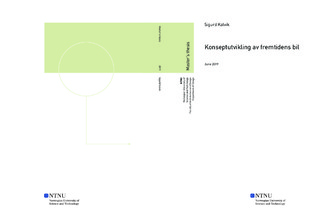| dc.contributor.advisor | Hareide, Einar | |
| dc.contributor.advisor | Bløndal, Johannes Sigurjonsson | |
| dc.contributor.author | Kalvik, Sigurd | |
| dc.date.accessioned | 2019-10-08T14:00:52Z | |
| dc.date.available | 2019-10-08T14:00:52Z | |
| dc.date.issued | 2019 | |
| dc.identifier.uri | http://hdl.handle.net/11250/2620983 | |
| dc.description.abstract | Det er pågående store forandringer i mobilitets sektoren, og et æra skifte i bilindustrien. Overgangen fra forbrenningsmotorer til elektriske kjøretøy er en økende trend, og store bilprodusenter om organiseres for å holde tritt med forandringene. I tillegg til overgangen mot en elektrisk fremtid, skjer det store teknologiske fremskritt innen autonom teknologi og delte mobilitets tjeneseter. Dette er banebrytende teknologi som vil prege fremtidens mobilitet drastisk både innen tjenester, infrastruktur og utforming/design.
Hvordan denne teknologiske utviklingen kan prege designet og funksjonene på fremtidens biler er oppgavens problemstilling. Problemstillingen skal løses gjennom skandinavisk formgivning og bruk av simple linjer.
Denne raporten fremstiller et studie gjort for å utvikle et konsept på fremtidens bil. teknologisk Innsiktsarbeid og designarbeid har virket sammen for utviklingen og design av et konsept plassert 10 år frem i tid. Designarbeidet inkluderer kreative teknikker som moodboards, hyppig skissering og tankeeksperimenter før det blir visualisert gjennom 3D modeller.
Resultatet er en konseptbil som er bygget opp av hovedsakelig tre elementer, et skateboard, en ramme, og en glasstoppen. Hvert av elementene er designet for å henge godt sammen både strukturelt og visuelt. Skateboardets inneholder alt av den autonome teknologien nødvendig for autonomi nivå 5. Et viktig element med konseptbilen er fraværet av knapper, skjermer og visuelle funksjoner i interiøret. Det er ønskelig at alt av nødvendig informasjon som fart, kart eller sidespeil skal projiseres på glasskupeen fra en enkel kilde på fremsiden av dashbordet. Operasjonen av bilens funksjoner skal skje gjennom en kombinasjon av talestyring og en sentral dimmer. | |
| dc.description.abstract | There are ongoing major changes in the mobility sector and an era shift in the automotive industry. The transition from internal combustion engines to electric vehicles is a growing trend, and car manufacturers are being organized to keep up with the changes. In addition to the transition to an electrical future, there is great technological advancement in autonomous technology and shared mobility services. This is ground breaking technology that will characterize future mobility drastically both in services, infrastructure and design.
How this technological development can characterize the design and functions of future cars is the problem discussed in this thesis. The problem should be solved through Scandinavian design and the use of simple lines.
This report presents a study done to develop a concept for the future car. Technological insight and design work have worked together for the development and design of a concept car placed 10 years ahead. The design work includes creative techniques such as mood boards, frequent sketching and thought experiments before being visualized through 3D models.
The result is a concept car built up of mainly three elements, a skateboard, a frame, and a glass top. Each of the elements is designed to hang well together both structurally and visually. The skateboard drivetrain contains all the autonomous technology needed for level 5 autonomy. An important element of the concept car is the absence of buttons, screens and visual features in the interior. It is desirable that all necessary information such as speed, map or exterior mirror is projected onto the glass top from a single source on the front of the dashboard. The operation of the car’s functions will be done through a combination of voice control and a central dimmer. | |
| dc.language | nob | |
| dc.publisher | NTNU | |
| dc.title | Konseptutvikling av fremtidens bil | |
| dc.type | Master thesis | |
